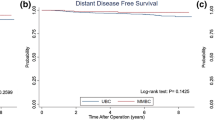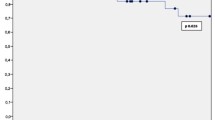Abstract
Background
Multifocality and multicentricity are increasingly recognized in breast cancer. However, little is known about the characteristics and biology of these cancers and the clinical implications are controversial.
Methods
A retrospective, institutional database was used to compare characteristics of multifocal (MF) and multicentric (MC) breast cancers with unifocal (UF) cancers to study concordance of histology and receptor status among primary and secondary foci and to evaluate predictors of lymph node positivity using multivariate logistic regression.
Results
Of 1495 invasive cancers, 1231 (82.3 %) were UF, 169 (11.3 %) were MF, and 95 (6.4 %) were MC cancers. When MF and MC cancers were compared with UF cancers, MC but not MF cancers were associated with young age at diagnosis, larger tumor size, lymphovascular invasion, and node positivity. MF but not MC tumors were more likely to be ER/PR+Her2+ tumors and less likely to be triple-negative cancers compared with UF tumors. MF tumors were more likely to be infiltrating ductal carcinomas with an extensive intraductal component, and MC tumors were more likely to be infiltrating lobular carcinomas. Concordance of histology and receptor status between primary and secondary foci was high and was similar for both MF and MC cancers. Multicentricity remained an independent predictor of lymph node positivity on multivariate analysis.
Conclusion
MF and MC tumors seem to be biologically different diseases. MC is clinicopathologically more aggressive than MF disease and is more frequently associated with younger age and larger tumor size and also is an independent predictor of node positivity.
Similar content being viewed by others
References
Cheatle G. Benign and malignant changes in duct epithelium of the breast. Br J Cancer. 1920;8(31):285–306.
Qualheim RE, Gall EA. Breast carcinoma with multiple sites of origin. Cancer. 1957;10(3):460–8.
Houssami N, Ciatto S, Macaskill P, et al. Accuracy and surgical impact of magnetic resonance imaging in breast cancer staging: systematic review and meta-analysis in detection of multifocal and multicentric cancer. J Clin Oncol. 2008;26(19):3248–58.
Sardanelli F, Giuseppetti GM, Panizza P, et al. Sensitivity of MRI versus mammography for detecting foci of multifocal, multicentric breast cancer in Fatty and dense breasts using the whole-breast pathologic examination as a gold standard. AJR Am J Roentgenol. 2004;183(4):1149–57.
Girardi V, Carbognin G, Camera L, et al. Multifocal, multicentric and contralateral breast cancers: breast MR imaging in the preoperative evaluation of patients with newly diagnosed breast cancer. Radiol Med. 2011;116(8):1226–38.
Jain S, Rezo A, Shadbolt B, Dahlstrom JE. Synchronous multiple ipsilateral breast cancers: implications for patient management. Pathology. 2009;41(1):57–67.
Bendifallah S, Werkoff G, Borie-Moutafoff C, et al. Multiple synchronous (multifocal and multicentric) breast cancer: clinical implications. Surg Oncol. 2010;19(4):e115–23.
Yerushalmi R, Tyldesley S, Woods R, Kennecke HF, Speers C, Gelmon KA. Is breast-conserving therapy a safe option for patients with tumor multicentricity and multifocality? Ann Oncol. 2012;23(4):876–81.
Ustaalioglu BO, Bilici A, Kefeli U, et al. The importance of multifocal/multicentric tumor on the disease-free survival of breast cancer patients: single center experience. Am J Clin Oncol. 2012;35(6):580–6.
Weissenbacher TM, Zschage M, Janni W, et al. Multicentric and multifocal versus unifocal breast cancer: is the tumor-node-metastasis classification justified? Breast Cancer Res Treat. 2010;122(1):27–34.
Oh JL, Dryden MJ, Woodward WA, et al. Locoregional control of clinically diagnosed multifocal or multicentric breast cancer after neoadjuvant chemotherapy and locoregional therapy. J Clin Oncol. 2006;24(31):4971–5.
Wolters R, Wockel A, Janni W, et al. Comparing the outcome between multicentric and multifocal breast cancer: what is the impact on survival, and is there a role for guideline-adherent adjuvant therapy? A retrospective multicenter cohort study of 8,935 patients. Breast Cancer Res Treat. 2013;142(3):579–90.
Lynch SP, Lei X, Chavez-MacGregor M, et al. Multifocality and multicentricity in breast cancer and survival outcomes. Ann Oncol. 2012;23(12):3063–9.
Katz A, Strom EA, Buchholz TA, Theriault R, Singletary SE, McNeese MD. The influence of pathologic tumor characteristics on locoregional recurrence rates following mastectomy. Int J Radiat Oncol Biol Phys. 2001;50(3):735–42.
Rezo A, Dahlstrom J, Shadbolt B, et al. Tumor size and survival in multicentric and multifocal breast cancer. Breast. 2011;20(3):259–63.
Cabioglu N, Ozmen V, Kaya H, et al. Increased lymph node positivity in multifocal and multicentric breast cancer. J Am Coll Surg. 2009;208(1):67–74.
Chua B, Ung O, Taylor R, Boyages J. Frequency and predictors of axillary lymph node metastases in invasive breast cancer. ANZ J Surg. 2001;71(12):723–8.
Edge S. AJCC cancer staging manual. New York: Springer; 2010.
Andea AA, Wallis T, Newman LA, Bouwman D, Dey J, Visscher DW. Pathologic analysis of tumor size and lymph node status in multifocal/multicentric breast carcinoma. Cancer. 2002;94(5):1383–90.
Coombs NJ, Boyages J. Multifocal and multicentric breast cancer: does each focus matter? J Clin Oncol. 2005;23(30):7497–502.
Boyages J, Jayasinghe UW, Coombs N. Multifocal breast cancer and survival: each focus does matter particularly for larger tumours. Eur J Cancer. 2010;46(11):1990–6.
O’Daly BJ, Sweeney KJ, Ridgway PF, et al. The accuracy of combined versus largest diameter in staging multifocal breast cancer. J Am Coll Surg. 2007;204(2):282–5.
Hilton JF, Bouganim N, Dong B, et al. Do alternative methods of measuring tumor size, including consideration of multicentric/multifocal disease, enhance prognostic information beyond TNM staging in women with early stage breast cancer: an analysis of the NCIC CTG MA.5 and MA.12 clinical trials. Breast Cancer Res Treat. 2013;142(1):143–51.
Dawson PJ, Baekey PA, Clark RA. Mechanisms of multifocal breast cancer: an immunocytochemical study. Hum Pathol. 1995;26(9):965–9.
Teixeira MR, Ribeiro FR, Torres L, et al. Assessment of clonal relationships in ipsilateral and bilateral multiple breast carcinomas by comparative genomic hybridisation and hierarchical clustering analysis. Br J Cancer. 2004;91(4):775–82.
Eeles R, Knee G, Jhavar S, et al. Multicentric breast cancer: clonality and prognostic studies. Breast Cancer Res Treat. 2011;129(3):703–16.
Middleton LP, Vlastos G, Mirza NQ, Eva S, Sahin AA. Multicentric mammary carcinoma: evidence of monoclonal proliferation. Cancer. 2002;94(7):1910–6.
Choi Y, Kim EJ, Seol H, et al. The hormone receptor, human epidermal growth factor receptor 2, and molecular subtype status of individual tumor foci in multifocal/multicentric invasive ductal carcinoma of breast. Hum Pathol. 2012;43(1):48–55.
Buggi F, Folli S, Curcio A, et al. Multicentric/multifocal breast cancer with a single histotype: is the biological characterization of all individual foci justified? Ann Oncol. 2012;23(8):2042–6.
Pekar G, Gere M, Tarjan M, Hellberg D, Tot T. Molecular phenotype of the foci in multifocal invasive breast carcinomas: intertumoral heterogeneity is related to shorter survival and may influence the choice of therapy. Cancer. 2014;120(1):26–34.
Boros M, Marian C, Moldovan C, Stolnicu S. Morphological heterogeneity of the simultaneous ipsilateral invasive tumor foci in breast carcinoma: a retrospective study of 418 cases of carcinomas. Pathol Res Pract. 2012;208(10):604–9.
Disclosure
None.
Author information
Authors and Affiliations
Corresponding author
Rights and permissions
About this article
Cite this article
Kanumuri, P., Hayse, B., Killelea, B.K. et al. Characteristics of Multifocal and Multicentric Breast Cancers. Ann Surg Oncol 22, 2475–2482 (2015). https://doi.org/10.1245/s10434-015-4430-6
Received:
Published:
Issue Date:
DOI: https://doi.org/10.1245/s10434-015-4430-6




